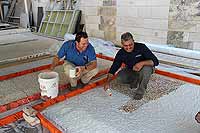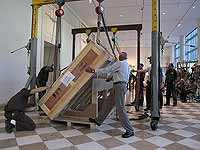|
|
 |
miscellaneous
About the Mosaic Conservation Section
Yael Fuhrmann-Naaman
This article was written following an interview I conducted with Ghaleb Abu Diab in March 2010 and includes recent updates.
Ghaleb Abu Diab, the head of the Mosaic Section of the Conservation Administration, volunteered for various jobs as a youngster in the Rockefeller Museum. His father was a pharmacist who worked in Herod’s Gate and thanks to his connections with the employees of the Department of Antiquities Ghaleb formed a special relationship with the staff of the Rockefeller Museum. Ghaleb officially started out in the Department of Antiquities in 1980, after having completed his Islamic studies in Hebron. At first he worked as a maintenance man and electrician, and among other things would help out with the conservation of mosaics and sites. Since 1987 he has concentrated on mosaic conservation, specialized in this field and has even implemented important innovations in it.
The subject of mosaic conservation has been previously addressed by Ghaleb’s predecessors. For him, however, dealing with mosaics is not just “work”; rather it is also a hobby and a place where he can express himself both personally and artistically. The first mosaic conservator in the Department of Antiquities was Raphael Vidal from Turkey, who was knowledgeable in the fields of construction and conservation. In 1955 Vidal and a number of other people were trained in mosaic conservation here in Israel, on behalf of UNESCO. He worked in the Department of Antiquities and Museums until his retirement in 1983. Vidal was replaced by archaeologist Hannah Kastenbaum for just one year after which she went on to work in the Israel Museum. Hava Yoffe, who was also trained in mosaic conservation by UNESCO, took her place. In the mid 1980’s Hava was instrumental in cataloguing all of the mosaics that were known in the country at the time. The information was compiled from the archive and was drawn from the knowledge possessed by field archaeologists, with the help of Ronny Reich and other archaeologists.
|
The mosaics that had been removed from their original locations and brought to the storerooms were systematically treated between the years 1987–1993.
With the establishment of the Israel Antiquities Authority in 1990, Ghaleb was appointed head of the Mosaic Section. At that time there were three employees engaged in mosaic conservation: Hava Yoffe, Ghaleb Abu Diab and Majed Diab. That year, for the first time, a 6 meter long mosaic from Khirbet el-Waziya was removed in its entirety on a wooden wheel.
Following the establishment of the Conservation Department in 1989, the mosaic storeroom was enlarged from 150 square meters to 400 square meters, thanks to the efforts of Arch. Giora Solar and Ing. Yaacov Schefer. The storeroom was reorganized with the help of the Israel Museum and the Ministry of Education. The development of conservation from a professional standpoint in the Israel Antiquities Authority and the integration of additional employees led to the formation of a dedicated team of experts in artistic conservation headed by Ing. Jacques Neguer, a conservator and chemical engineer by training. At that time the artist Haim Kapchitz and conservator Hona Finkel, who have since retired, joined the staff. The Mosaic Section was transferred to this department.
|
Currently, there are sixteen employees and two volunteers at work in the Artistic Conservation Branch. Almost all of them have acquired their knowledge and experience mainly from their work in the Conservation Administration that was established from the Conservation Department in 2009.
|
 |
|
Treating a mosaic in the workshop in the Rockefeller Museum courtyard. Photograph: Yael Fuhrmann-Naaman.
|
Conservation techniques have changed in light of the experience and knowledge accumulated over the years. According to Ghaleb, until 1948 mosaic foundations were primarily treated utilizing cement, straw and bone glue. At the time of the Mandate the British would use cast cement reinforced with iron in the mosaic foundations.
Almost no mosaic conservation measures were undertaken in the country between the years 1948 and 1955. This area of conservation gained momentum with the UNESCO course that was mainly conducted on the Khirbet al-Miqarqesh mosaic from Bet Guvrin. The intervention included removing pieces of the mosaic from its site and casting them in concrete reinforced with mesh (without the layer of steel separating the concrete from the tesserae). Over the years it has become apparent that that technique was detrimental to the mosaics because the iron rods oxidized and swelled thereby causing the mosaic to break apart. Consequently, already at the time of Vidal, they inserted iron rods 4–8 mm thick in the concrete castings. First they cast the concrete directly on the tesserae and later the conservators added a layer that separated the casting from the tesserae. This layer was a mixture of quarry sand, cement and lime. Lacunae were then filled with a mixture of sea sand and black cement that could be easily dismantled after the casting dried, and if necessary could be completed with mortar and tesserae. This technique was used until 1988 when Ghaleb began refining it. That year was the first time a concrete casting was dismantled from a mosaic. The black cement was replaced with white cement and instead of iron rods aluminum rods were utilized. Ghaleb’s guiding principle in finding conservation solutions was to implement castings that could be reversed and easily detached from the mosaic in the future. In the past fifteen years numerous mosaics have been treated a second time which were removed from their sites on top of concrete castings.
|
 |
|
|
According to Ghaleb, “Since 1990 we have been using an aluminum frame and polyurethane mixed with fiberglass for reinforcement of the casting. These castings are half the weight of the panels that were cast in cement and iron. When they began using epoxy glue elsewhere in the world and in the Israel Museum, we had to find less expensive substitutes hence we had to think creatively. Over the years hundreds of experiments were done to reach the optimal composition of materials for the mosaics. The field of mosaic conservation is progressing not only in Israel, and is characterized by the international exchange of information and cooperation. Since the 1990s we have been asked to cooperate in international research led by Jacques Neguer. We began using eurolam in the castings, in accordance with what we learned from Italian experts that worked in Cyprus. Reducing the weight of the casting made it possible for us to work on large panels – mosaics measuring 4 × 4 meters and 3 × 6 meters – and move them about more easily for purposes of conservation and exhibition. The knowledge accumulated from the experience and research led to the formulation of professional standards in mosaic conservation”.
|
 |
|
Setting up the exhibition at the Metropolitan Museum of Art, New York. Photograph: Ghaleb Abu Diab.
|
Ghaleb and the other mosaic conservators have removed more than 7,500 square meters of mosaics from sites throughout the country, of which c. 2,000 square meters were returned to their original locations after conservation; more than 400 ancient mosaic panels are exhibited in different places, in museums and in public institutions such as Ben-Gurion airport, the Presidential Residence, Supreme Court, Interdisciplinary Center in Herzliya etc.
Furthermore, Israel is not the only place where there is a demand for the works treated in the mosaic conservation workshop. These days the Lod Mosaic is on display at some of the world’s most famous museums. It was exhibited in New York (Metropolitan Museum of Art), San Francisco (Legion of Honor), Chicago (Field Museum), Columbus, Ohio (Columbus Museum of Art), University of Pennsylvania (Penn Museum) and it is currently on display in Paris (the Louvre). From there it will go to Berlin (Altes Museum) and in 2014 the mosaic will be exhibited in London.
By the time it completes its “tour” of America and Europe it is slated to return to its original location, to the city of Lod, to its new home, the Lod Mosaic Museum which is currently being planned. There is no doubt that not only the artistic qualities of the mosaic brought it to such far off places, but the professional skills of those engaged in mosaic conservation, their acquired knowledge and experience, as well as their ability to invent and innovate also made it possible for the mosaic’s international exhibition.
Ghaleb and his fellow conservators aspire to technological innovation and to continue to lead the world in this field. They are greatly aware of the need to preserve the knowledge and experience and transfer it to the next generation of conservators, as well as field archaeologists who are often times responsible for the first steps in the process of a mosaic’s conservation.
|
The opening of the exhibition at the Metropolitan Museum of Art. Photograph: Kobi Fisch
|
-------------------------
MAY 2013
-------------------------
|
|
|
|
|


